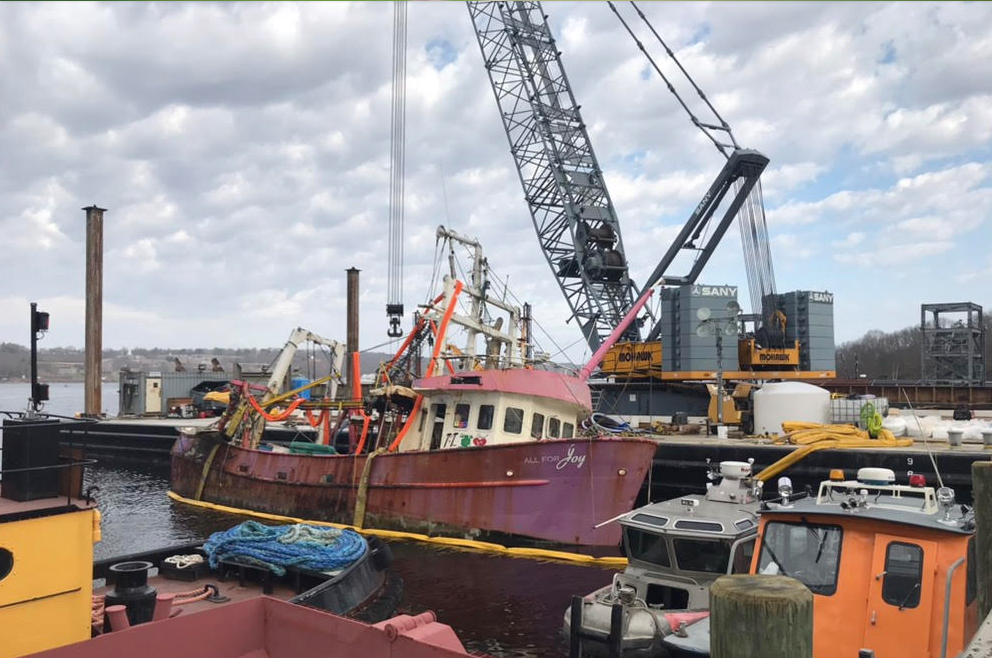 Fishing vessel “All for Joy”, with yellow spill boom in place, is secured to a barge at Mohawk Northeast, Inc., Thames River, New London/Groton CT. Joe & Tracy Brock Photo
Fishing vessel “All for Joy”, with yellow spill boom in place, is secured to a barge at Mohawk Northeast, Inc., Thames River, New London/Groton CT. Joe & Tracy Brock Photo
It took 20 days, but the capsized fishing vessel “All for Joy” was finally removed from the mouth of Hay Harbor at 6:05 p.m. Mar. 30.
The commercial fishing vessel capsized south of the Race March 10 and eventually came to rest at the mouth of Hay Harbor, leaking fuel that reached to the shore of Fishers Island. Two fishermen were rescued unharmed.
By 6:30 a.m. March 12, the smell of diesel fuel was “overpowering” on the north side of the Island, particularly at North Hill west past Hay Harbor. Heavy winds and seas prevented divers from safely capping the leaking fuel at that time, because there were too many hazardous pieces hanging and floating around the capsized vessel.
According to the US Coast Guard, all of the tanks on the vessel had been capped by Mar. 13. The current, tide and winds took the fuel into Hay Harbor and along Stony Beach. A crew from Clean Harbors walked the shoreline Mar. 14 to mop up any remaining oil with absorbent pads. They also deployed absorbent booms in those areas where oil was most prevalent. (Reporting by Jane T. Ahrens.)
Out from Under the Woodwork*
From the Field, Video SnippetsBlack-crowned night herons (BCNH)* appear to be everywhere these days, especially out from under the ferry dock on Fishers Island.
At about three years of age, this heron sports its “adult plumage”.
’Tis the breeding season, with two long, white plumes flitting in the breeze.
*Silver eel Cove
From the Field, Video Snippet, Justine Kibbe, April 11, 2019
Duck Pond’s Paint by Number
Field Notes, From the FieldEastern painted turtles gathering between sun and shadow.
From the Field, Field Note, Justine Kibbe, April 9, 2019
Crown Royal
Field Notes, From the FieldBlack-crowned Night Heron roosting this afternoon in treetops within Ferguson Museum Sanctuary, Fishers Island. At just about sunset, this nocturnal resident will forage for fish at Duck pond.
With remarks From the Field, this week marks the return of Great Blue Herons as well as Great Egrets, especially in coves northside.
Keep your eyes peeled…
From the Field, Field Note, Justine Kibbe, April 9, 2019
Black-Crowned Night Heron
From the Field, Video SnippetsBlack-crowned Night Heron roosting this afternoon in treetops within Ferguson Museum Sanctuary, Fishers Island. At just about sunset, this nocturnal resident will forage for fish at Duck pond.
With remarks From the Field, this week marks the return of Great Blue Herons as well as Great Egrets, especially in coves northside.
Keep your eyes peeled…
From the Field, Video Snippet, Justine Kibbe, April 9, 2019
Piping Plovers Return to Fishers Island
NewsPiping Plover pair returns to Fishers Island. House hunting on Sanctuary of Sands, South Beach.
FIConservancy Naturalist Justine Kibbe has been monitoring Piping Plovers in the South Beach area of Fishers Island for several years. Officially designated a “threatened” species, Piping Plovers are named for their melodic mating call.
Piping plovers eat freshwater and marine invertebrates that wash up on shore. They require a specific habitat to survive and are therefore an indicator of the “health” of a marine area. Their speckled eggs blend seamlessly into the coastal environment. Please tread lightly.
Two’s Company
Field Notes, From the FieldPiping Plover pair returns. House hunting on Sanctuary of Sands, Fishers Island.
Please tread lightly.
From the Field, Field Note, Justine Kibbe, April 6, 2019
You’ve Come a Long Way
From the Field, Video SnippetsThere is still a lot to learn about the lives of Piping Plovers during their winter migration. These delicate shorebirds can fly as far as the Gulf of Mexico before returning to the North Atlantic coast. With development and disappearing habitat, we can only imagine the effort these winged visitors expend to come home to this safe sandy spot on Fishers Island.
Although these two Piping Plovers are not banded, I’m grateful to see the “same pair” return after several years of monitoring.
*site fidelity
From the Field, Video Snippet, Justine Kibbe, April 6, 2019
Healthy Outlook for Healthy Habitat
Field Notes, From the FieldLet’s Welcome the Least Terns
Field Notes, From the FieldCapsized Vessel Finally Removed from Mouth of Hay Harbor
NewsIt took 20 days, but the capsized fishing vessel “All for Joy” was finally removed from the mouth of Hay Harbor at 6:05 p.m. Mar. 30.
The commercial fishing vessel capsized south of the Race March 10 and eventually came to rest at the mouth of Hay Harbor, leaking fuel that reached to the shore of Fishers Island. Two fishermen were rescued unharmed.
By 6:30 a.m. March 12, the smell of diesel fuel was “overpowering” on the north side of the Island, particularly at North Hill west past Hay Harbor. Heavy winds and seas prevented divers from safely capping the leaking fuel at that time, because there were too many hazardous pieces hanging and floating around the capsized vessel.
According to the US Coast Guard, all of the tanks on the vessel had been capped by Mar. 13. The current, tide and winds took the fuel into Hay Harbor and along Stony Beach. A crew from Clean Harbors walked the shoreline Mar. 14 to mop up any remaining oil with absorbent pads. They also deployed absorbent booms in those areas where oil was most prevalent. (Reporting by Jane T. Ahrens.)